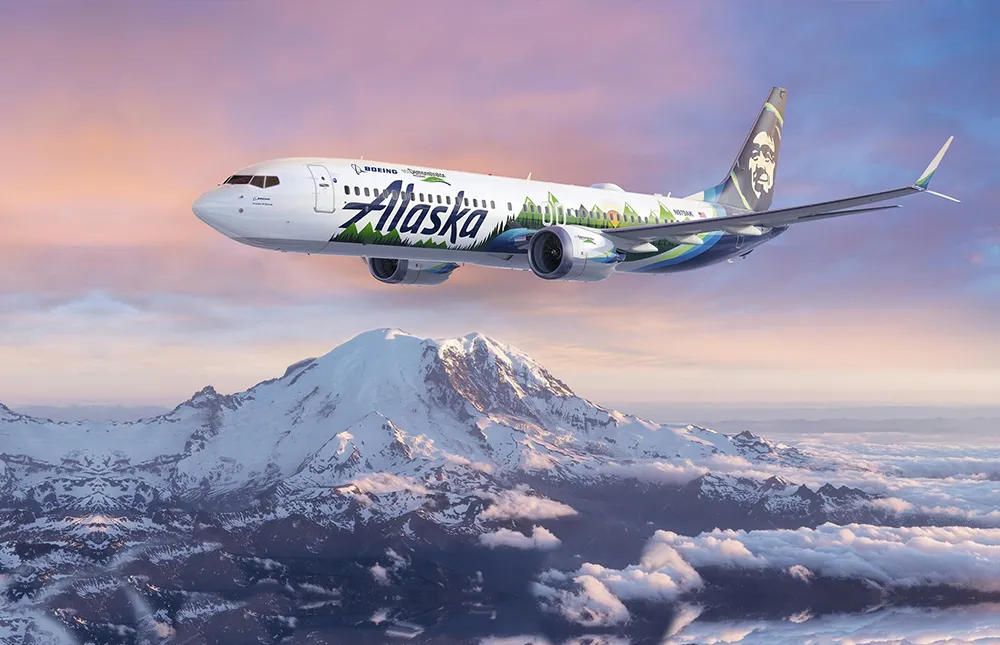
Alaska Airlines faced a significant operational challenge as it made the unprecedented decision to ground all Boeing 737-9 planes following a mid-air window blowout incident. The airline, known for its commitment to safety, took swift action to assess and address the situation, prioritizing the well-being of passengers and crew.
The incident unfolded during a routine flight, causing alarm as one of the windows shattered mid-air. Passengers reported a sudden, loud noise accompanied by the frightening sight of the fractured window. The flight crew promptly initiated emergency procedures, diverting the aircraft to the nearest suitable airport for an immediate landing.
Upon landing, the affected aircraft underwent a thorough inspection by Alaska Airlines’ maintenance teams, who discovered concerning anomalies in the window structure. The decision to ground all Boeing 737-9 planes in the fleet followed a meticulous evaluation of safety protocols and the need to prevent any potential recurrence of such incidents.
The grounding has ripple effects on Alaska Airlines’ operations, leading to flight cancellations and disruptions across its network. The airline, in collaboration with Boeing, is working tirelessly to investigate the root cause of the window blowout and implement necessary modifications to ensure the safety of its fleet.
Passenger’s Safety
Passenger safety is paramount for any airline, and Alaska Airlines is leaving no stone unturned in addressing the issue with the urgency it demands. The decision to ground an entire aircraft type underscores the airline’s commitment to a proactive and precautionary approach, prioritizing safety over operational considerations.

Boeing, the aircraft manufacturer, is collaborating closely with Alaska Airlines in the investigation. Preliminary findings suggest a potential flaw in the window design specific to the Boeing 737-9 series, prompting both companies to collaborate on immediate corrective measures. This incident comes at a time when Boeing is still recovering from the reputational fallout of previous safety concerns with its 737 MAX series.
The grounding has a wider impact on air travel, as other carriers with Boeing 737-9 planes in their fleets assess their own safety protocols. The aviation industry, characterized by rigorous safety standards, often experiences a domino effect when a major carrier takes such decisive safety measures.
For passengers, the incident raises concerns about the safety of aircraft and the efficacy of maintenance procedures. However, industry experts assert that such incidents are exceedingly rare and that the grounding of an entire fleet is an indication of the airline’s commitment to a rigorous safety culture.
Alaska Airlines has been proactive in communicating with affected passengers, offering rebooking options, refunds, and other accommodations. The airline’s customer service teams are working diligently to manage the fallout and minimize inconvenience for travelers caught up in the disruptions.
As investigations continue, the aviation industry is closely watching how Alaska Airlines and Boeing navigate the aftermath of this incident. The implications extend beyond the immediate operational challenges, influencing passenger confidence and industry-wide safety evaluations.
The aftermath of the mid-air window blowout has prompted regulatory bodies, such as the Federal Aviation Administration (FAA), to intensify their scrutiny of the affected aircraft type. The FAA, along with other global aviation authorities, is collaborating with Boeing and Alaska Airlines to conduct thorough reviews of the incident and assess the overall safety of the Boeing 737-9 series.
This incident has broader implications for Boeing, which has been working diligently to restore trust in its aircraft after the challenges faced with the 737 MAX. The company’s reputation for safety and reliability is once again under scrutiny, and stakeholders are closely monitoring Boeing’s response and the corrective actions it implements.
The aviation industry is inherently resilient and adaptive. Instances of safety concerns often lead to comprehensive reviews and enhancements in safety protocols, contributing to the continuous improvement of air travel safety. Lessons learned from incidents like these become catalysts for refining and reinforcing industry-wide safety standards.
As Alaska Airlines navigates the complexities of the situation, the airline industry as a whole is reminded of the delicate balance between operational efficiency and uncompromising safety standards. The incident underscores the shared responsibility of airlines, manufacturers, and regulatory bodies to prioritize and uphold the highest levels of safety in commercial aviation.
Passenger safety remains at the forefront of discussions surrounding this incident. The proactive measures taken by Alaska Airlines, including the grounding of the entire fleet, demonstrate a commitment to transparency and a willingness to prioritize passenger well-being over operational considerations. This approach, while causing disruptions, serves as a testament to the airline’s dedication to maintaining the trust of its passengers.
Looking ahead, the incident prompts a broader reflection on the resilience of the aviation industry. While challenges arise, the commitment to safety, collaboration among stakeholders, and continuous improvement ensure that the industry evolves and adapts to maintain its position as one of the safest modes of transportation.


